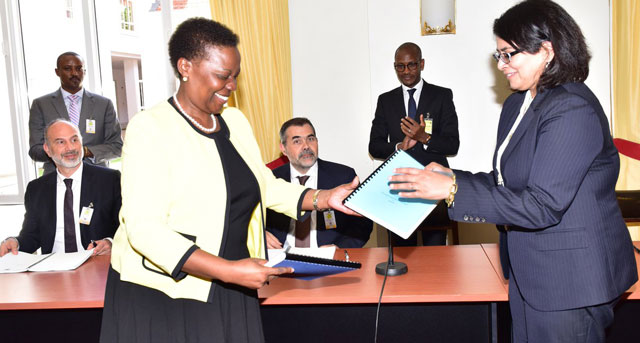
Kampala, Uganda | THE INDEPENDENT | The signing of the Project Framework Agreement between government and the Albertine Graben Refinery Consortium (AGRC) for USD4 billion oil refinery was a great relief to the Energy Ministry as it races towards first Oil by 2020.
Sources at the Energy Ministry have indicated to URN that it took a lot of behind the scenes negotiations that would at times involve President Museveni on side and the United States government through its Embassy in Kampala.
The US Embassy was, according to sources, eager to see the conclusion of the deal in order to fight off Chinese firms still interested the multi-billion Dollar deal in case the negotiations with Albertine Graben Refinery Consortium failed.
Over 40 companies had expressed interest in the deal which was initially thought to cost USD 3 Billion but now projected to cost up to USD 4billion.
The negotiations between the government represented by the Ministry of Energy, the National Oil Company and Albertine Graben Refinery Consortium commenced at the beginning of August 2017 when the two agreed on the core project terms.
The selection process started in January 2017. At the time, it was anticipated that Chinese firm Guangzhou DongSong Energy Group which had scored highly during the second search would take the deal. URN did not independently establish whether Guangzhou DongSong Energy Group was still in Uganda from the time the Group was dropped from the deal.
The then energy Ministry Permanent Secretary, Dr Stephen Isabalija, however, announced that the Albertine Graben Refinery Consortium (AGRC) made up of General Electric (GE) Oil and Gas, YAATRA Ventures LLC, Intracontinental Asset Holdings Ltd (IA) and Saipem SpA had clinched it.
The project Framework Agreement with Albertine Graben Refinery Consortium (AGRC) should have been signed within months after they had agreed on the core terms. A source indicated that Chinese firms have quietly tried to find their way back into the deal backed by some government officials that have preferred working with China.
Uganda’s Oil and Gas sector is one of the sectors promoted by the US Commercial Service of the Department of Commerce. The 2017 US Commercial country guide on Uganda pointed the USD10 billion infrastructure required to develop Uganda’s oil reserves as one the opportunities for the American in Uganda.
This explains why the signing of the agreement did not only excite the Energy Ministry officials but the US Embassy too.
US Ambassador Deborah R. Malac called a select number of journalists to the embassy. Key on the on the topics was the Albertine Graben Refinery Consortium (AGRC) deal.
She says her Embassy was quite pleased with the signing of the agreement between the government of Uganda and the Albertine Graben Consortium which she said was put together by a US-led company.
Malac said the AGRC Consortium which includes General Electric, one of the largest global companies with over one hundred years of existence made the American firm competitive.
The almost year-long negotiations have centred on financing arrangements, risk mitigation measures among others. The consortium now has the rights and rights and licenses to develop and manage the refinery as lead investor in a joint venture partnership with Government.
One of the sticky issues under the back and forth related to regulations on the consortium itself and other related laws.
Under the Petroleum (Exploration, Development and Production) Act, joint ventures may be licensed to participate in a range of petroleum-related business undertakings provided there is, within such a joint venture, participation by the Ugandan government or a company that is at least 48 percent Ugandan-owned.
Ambassador Malac revealed that agreeing on the regulations was not as easy as envisaged at the time when they agreed on the core project terms.
She revealed that it had to take an education process to help the government team to understand how it worked. That she said could have partly delayed it.
Joint ventures have become popular especially among the US refinery companies because of their competitive edge. The companies there look to joint ventures, alliances, and other combinations to try to improve performance.
It is anticipated that the Joint Venture arrangement will help the companies under the consortium and the government financing mobilization for the project.
Ambassador Deborah Malac alluded to the fact that funding into the consortium will not be borrowed from other governments or loan money that will have to be paid back.
The private sector companies under the Joint Venture are expected to go to the Capital markets, find investors and share the risk of building and operating the refinery.
More details about the deal between the governments with the Consortium remained guarded with the Energy Ministry, National Oil Company lawyers as well as the US Ambassador reluctant to disclose.
Ambassador Malac said the non-disclosure practice is a globally established practice.
Ugandan National Company, Executive Director, Josephine Wapakabulo could not be reached for more details regarding the sharing arrangements
Crude oil reserves in Uganda are estimated at about 6,500 million barrels. The refinery to be based in Hoima is expected to process between 50,000 to 60,000 barrels per day.
****
URN
 The Independent Uganda: You get the Truth we Pay the Price
The Independent Uganda: You get the Truth we Pay the Price



